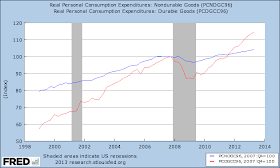- by New Deal democrat
In July monthly data reported this past week, existing home sales rose, while new home sales fell sharply, confirming that higher interest rates are having an impact on that important, leading market. Meanwhile the Index of Leading Indicators rose sharply. A year ago this index was stalled, but it has been more consistently positive in the last 9 months, suggesting that the remainder of this year will continue to show economic expansion.
One blind spot in the high frequency weekly indicators I've been trying to fill in is manufacturing, since it would be helpful to compare it with transport. There are several weekly indexes, but these appear to mainly work backward from rail transport. I finally found one direct measure of at least one sector, so let me spotlight that this week:
Steel production from the American Iron and Steel Institute
+0.9% w/w
-1% YoY
Steel production over the last several years has been, and appears to still be, in a decelerating uptrend. Obviously there is some noise in the weekly numbers. Last week it was off -1.7% YoY, so we can start by watching to see if the uptrend re-asserts itself in the next several weeks.
Employment metrics
Initial jobless claims
- 333,000 up +13,000
- 4 week average 330,500 down -1500
The American Staffing Association Index was unchanged at 96. It is up +3.9% YoY
Tax Withholding
- $119.2 B for the first 16 days of August vs. $111.0 B last year, up +8.2 B or +7.4%
- $147.1 B for the last 20 reporting days vs. $132.4 B last year, up +14.7 B or +11.1%
This week the four week average of initial claims made a new nearly 6 year low, placing it firmly in a normal expansionary mode. Interestingly, it has been at this point in the year for each of the last three years that this same, good, downside breakout has occurred.
Temporary staffing had been flat to negative YoY for a few months, but has now also broken out positively. Tax withholding, which had one of its worst readings in the last 7 months last week, is back within its normal range for most of this year.
Consumer spending
- ICSC -1.9% w/w +2.2% YoY
- Johnson Redbook +3.4% YoY
- Gallup daily consumer spending 14 day average at $87 up $3 YoY
Oil prices and usage
- Oil down -1.04 to $106.42 w/w
- Gas $3.55 down -0.01 w/w
- Usage 4 week average YoY up +2.2%
Interest rates and credit spreads
- 5.44% BAA corporate bonds up +0.10%
- 2.73% 10 year treasury bonds up +0.11%
- 2.71% credit spread between corporates and treasuries down -0.01%
Housing metrics
Mortgage applications from the Mortgage Bankers Association:
- +1% w/w purchase applications
- +5% YoY purchase applications
- -8% w/w refinance applications
Housing prices
- YoY this week +10.3%
Real estate loans, from the FRB H8 report:
- down -20 or -0.6% w/w
- up +0.1% YoY
- +1.1% from its bottom
Money supply
M1
- -1.4% w/w
- +1.4% m/m
- +7.9% YoY Real M1
M2
- -0.2% w/w
- +0.9% m/m
- +5.1% YoY Real M2
Transport
Railroad transport from the AAR
- +1500 carloads up +0.5% YoY
- +800 carloads or +0.5% ex-coal
- +9700 or +3.7% intermodal units
- +10,800 or +2.0% YoY total loads
- Harpex up 3 to 406
- Baltic Dry Index up +63 to 1165
Bank lending rates
- 0.24 TED spread up +0.02 w/w
- 0.184 LIBOR unchanged w/w
JoC ECRI Commodity prices
- down -0.46 to 124.53 w/w
- +3.34 YoY
Before we get to the other issues, let's deal with the collapse in Gallup consumer spending. This isn't the only Gallup indicator which has collapsed over the last week or so. Gallup's unemployment rate survey increased a full percent over the last two weeks. Gallup consumer confidence also fell sharply. But the other measures of both consumer spending and employment reported above have held up nicely, or even improved. So we are left with explalining why there has been a sudden sharp downturn in all of Gallup's consumer metrics, but only in Gallup's consumer metrics. Either (1) there has been a sudden but hidden crash in the economy over the last several weeks, or (2) Gallup got an unrepresentative survey panel, as is going to happen from time to time in such surveys. Until I see evidence backing up the cliff-diving of Gallup's consumer metrics, I'm going with (2).
Otherwise, there were only 3 negatives this week: interest rates, housing loans, and the still elevated price of Oil. Steel production was positive week over week, while negative (but less so, and the overall trend is still up) YoY.
Everything else was either weakly or strongly positive. Tax withholding and commodities were weakly positive. House prices, the ICSC and JR measures of consumer spending, temporary staffing, jobless claims, gas prices and usage, money supply and bank rates, interest rate spreads, and both rail and shipping transportation, were all solidly positive.
Although several of the long leading indicators - interest rates and housing - are problematic, the shorter leading indicators in both the ECRI WLI and the Conference Board's LEI point to nearer term imporovement. Have a nice weekend.








































